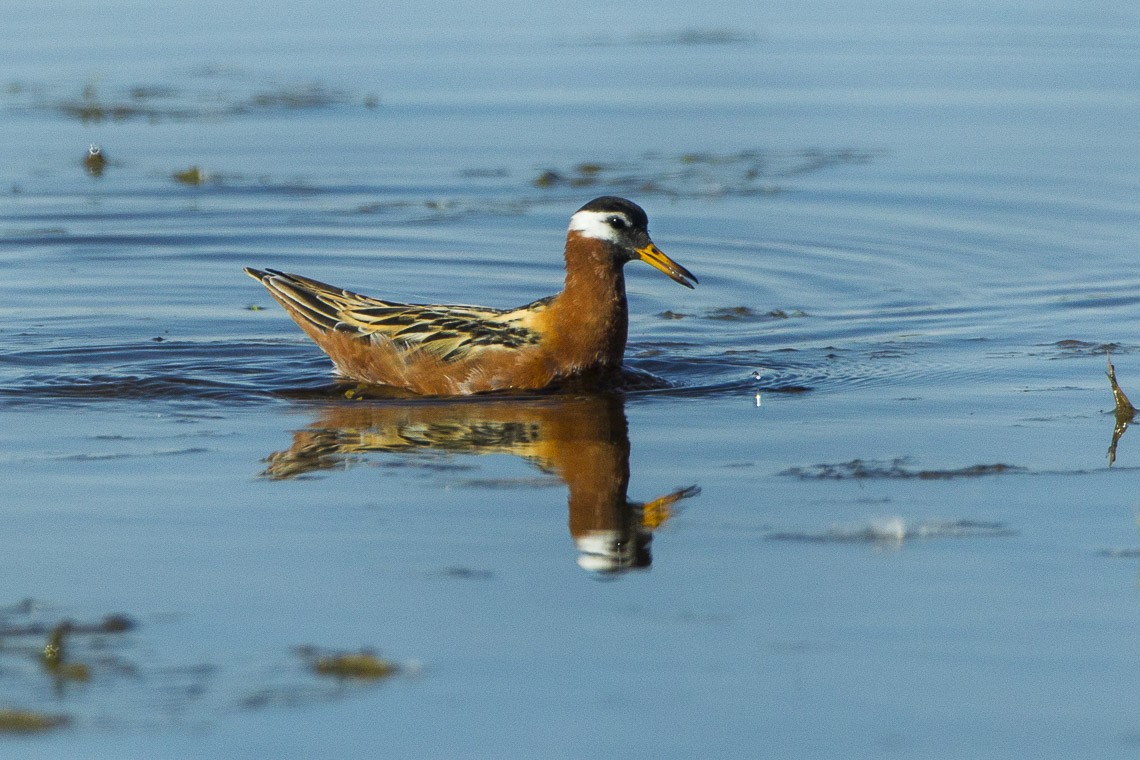Red Phalarope
A species of Phalaropes, Also known as Grey Phalarope Scientific name : Phalaropus fulicarius Genus : Phalaropes
Red Phalarope, A species of Phalaropes
Also known as:
Grey Phalarope
Botanical name: Phalaropus fulicarius
Genus: Phalaropes
Content
Description General Info
 Photo By Francesco Veronesi , used under CC-BY-SA-2.0 /Cropped and compressed from original
Photo By Francesco Veronesi , used under CC-BY-SA-2.0 /Cropped and compressed from original Description
The red phalarope is about 21 cm (8.3 in) in length, with lobed toes and a straight bill, somewhat thicker than that of red-necked phalarope. The breeding female is predominantly dark brown and black above, with red underparts and white cheek patches. The bill is yellow, tipped black. The breeding male is a duller version of the female. Young birds are light grey and brown above, with buff underparts and a dark patch through the eye. In winter, the plumage is essentially grey above and white below, but the black eyepatch is always present. The bill is black in winter. Their call is a short beek. 
Size
20-23 cm (8-9 in)
Life Expectancy
6 years
Nest Placement
Ground
Clutch Size
1 - 4 eggs
Incubation Period
1 brood
Number of Broods
17 - 26 days
Feeding Habits
Red Phalarope predominantly feeds on marsh insects like midges and cranefly larvae on breeding grounds, often in shallower waters. At sea, their diet consists mainly of zooplankton, including copepods, amphipods, as well as fish eggs and larvae. They also consume insects, mollusks, and crustaceans.
Habitat
Red Phalarope predominantly inhabits open ocean regions, often found in the Atlantic Ocean along the west coast of Africa, from Morocco to Namibia, and the Pacific off California and Peru. During breeding season, red Phalarope favors Arctic tundra where specific environmental conditions include low-lying, wet areas for nesting. The species thrives in the frigid climate of the high Arctic, involving a stark landscape with minimal vegetation, primarily constituted of mosses, lichens, and low shrubs.
Nest Behavior
Both sexes select the site; after the first egg is laid, the male enhances the nest. Red Phalarope has unique parental roles; the female leaves the male to incubate the eggs and care for the young.
Nest Characteristics
Red Phalarope's nest is typically a simple ground scrape amid tundra vegetation, often concealed with vegetation like sedges. It may include grass, sedge, willow, lichens, feathers, or stones.
Dite type
Aquatic invertebrate eater
General Info
Feeding Habits
Bird food type
Sounds
Call
Recording location: United States
Call
Recording location: United States
Behavior
Red Phalarope showcase a variety of feeding behaviors, including both wading in shallow waters and foraging at sea where they are known to drift with currents or create whirlpools to dislodge prey. These birds often aggregate around marine mammals to capitalize on crustaceans disturbed by their feeding activities. Unique among shorebirds, red Phalarope exhibit a polyandrous mating system, with females competing for males and subsequently leaving them with parental duties, as females may seek additional mating opportunities.
Species Status
The red phalarope is one of the species to which the Agreement on the Conservation of African-Eurasian Migratory Waterbirds (AEWA) applies. 
Scientific Classification
Phylum
Chordates Class
Birds Order
Shorebirds Family
Sandpipers Genus
Phalaropes Species
Red Phalarope